Hockey drills for technique hitting
- A passes deep to B, B goes around behind pilons and gives the ball to A in front, A scores on goal;
- B goes back to position, offers himself and gets the ball from C. CB play a 2v1 against A;
- A enters the ball at D gets ball and plays (D, E and A) a 3v2 against CB.
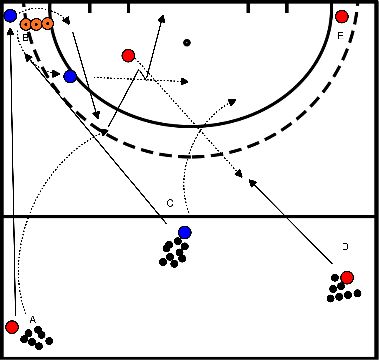
Game with different variations:
- with grip
- with globe
- with stick in weird position
- with other balls
- Player A runs left towards the pilon straight ahead and retrieves the ball so that the pilon is played out.
- Then player A passes the ball deep on to player B, who runs in.
- Player B puts the ball back to player A
- Player A finishes.
Then player A does the task of player B and vice versa.
- Player A plays the ball to Player B, who comes running into the ball.
- Player B bounces the ball directly back and runs towards the corner edge circle with a slalom through the gates.
- Player A runs towards the first pole to perform a tip in
Exercise is set up in the middle.Player A becomes player B and vice versa.
- The trainer (T) rolls the ball (1) to one of the four front players (for example A).
- Player A receiving the ball (2) plays a duel with player V1 opposite him.
- The goal is to score the ball at the opponent's goal.
- If V1 manages to intercept the ball, he plays it to V2.
- Now V2 may try to score with player B.
- After a goal, the form of play starts over again.
Making it easier
- Play a 1-1 duel on the two fields for a few minutes, after a goal, the substitute player comes into play.
Make it more difficult
- After the ball is taken by V1, V1 and V2 may try to score against player A (now it has become a 2-1 game).
- A has to defend.
- If A takes the ball, he plays it to player B.
- Player A and B play a 2-2 duel on players V1 and V2.
- It works just like a normal game only now there's a square in the middle.
- If a shot or other foul is made, or if the ball has been out of bounds, the trainer throws/plays in a new ball from inside the square.
- The ball does not necessarily go to the same team or at the place where the foul was made.
- The size of the field depends on the number of players.
- Player 1 plays the ball to player 2 after which player 1 runs through
- Player 2 bounces the ball back to Player 1,
- Player 1 aligns the ball between the pilons (The player is not going to run into the "pilon box".)
Player 1 then finishes the ball at goal
You can speed up this exercise by placing the mirrored exercise on the other side, allowing you to play from 2 sides.
Aim:
To become physically as well as technically warm as preparation for the training.
Set up:
The exercise will be done with a maximum of 4 people. Of course you can put a multiple of these so that the exercise still works.
1. The players 1 start with the ball and play it to their players 2. Then they change positions.
2. Players 2 play the ball back to players 1 and also change positions.
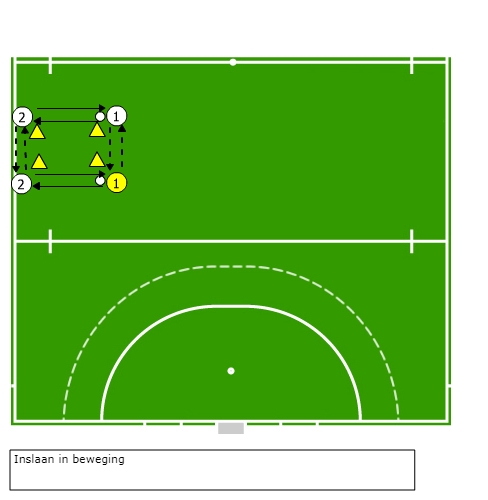
Variations:
- You can vary the way of passing (hitting, push, flats)
- Increase the distance between the pilons that players only has to run further.
- Increase the distance between the pilons that players have to pass over longer distances
- Increase both distances.
- Increase speed.
- Make as many successful passes as possible in time.
Points of attention:
- Sit low for a good control.
- Stick to the ground at ball control.
- Play the ball on the forehand side.
- Stand still while performing a ball control.
- Person 1 dribbles with the ball, does a 3D trick
- and passes a backhand to player 2 while running.
- Player 2 passes the ball to player 3 in the run.
- He dribbles along the obstacles and does a 3D trick at the end,
- Then player 3 hits the goal with a backhand shot.
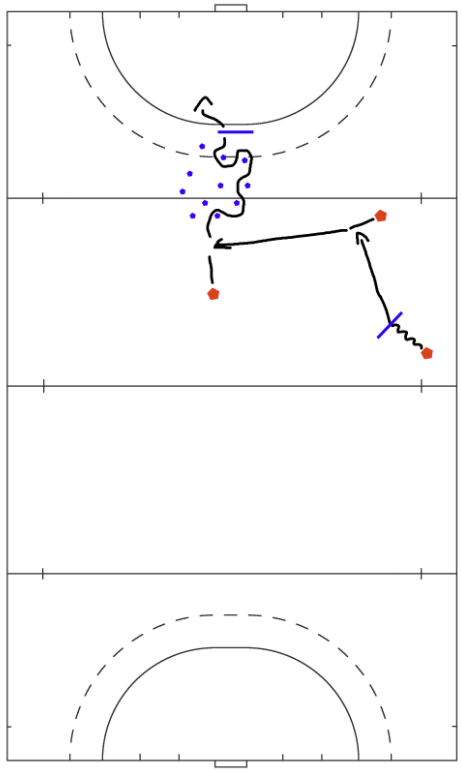
Aim:
- To become physically as well as technically warm as preparation for the training.
Design:
- The exercise will be done with a maximum of 4 people.
- Of course you can put a multiple of these so that the exercise still works.
- The players 1 start with the ball and play it to their players 2. Then they change positions.
- Players 2 play the ball back to players 1 and also change positions.
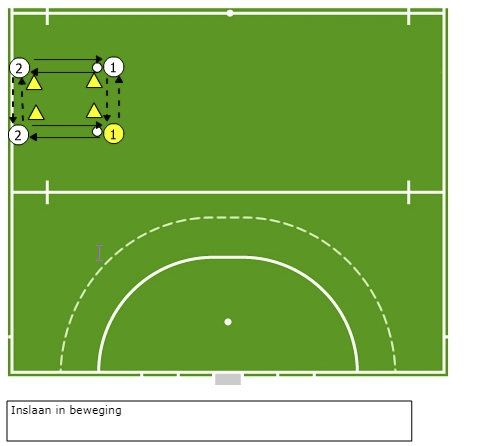
Variations:
- You can vary the way of passing (hitting, push, flats)
- Increase the distance between the pilons so that one only has to walk further.
- Increase the distance between the pilons so that one only has to move on.
- Increase both distances.
- Increase speed
- Make as many successful passes as possible in time.
Points of attention:
- Sit low for good control.
- Stick to the ground at ball control.
- Play ball on the forehand side.
- Stand still at ball acceptance.
- Put out gates of pilons (2 meters wide). from sideline to sideline.
- Players get 3 balls on the sideline
- any ball they can pass through a gate
- In advance, the player indicates which gate he is going to play through
- Each gate has points, the further the gate the higher the points:
- 10 Meter gate = 1 point
- 15 meter gate =5 points
- 20 meter gate = 10 points
- 30 meter gate is =20 points
- 40 meter gate = 30 points
- See how many points each player scores, this makes it clear to the players that a long-distance pass is often not very accurate.
- In addition, you can show that pushing and flatting can be much more convenient than hitting.
- You can put (depending on the level) a square of 3M x3M on the field and if the players score and the ball lands in the square it is worth 50 points.
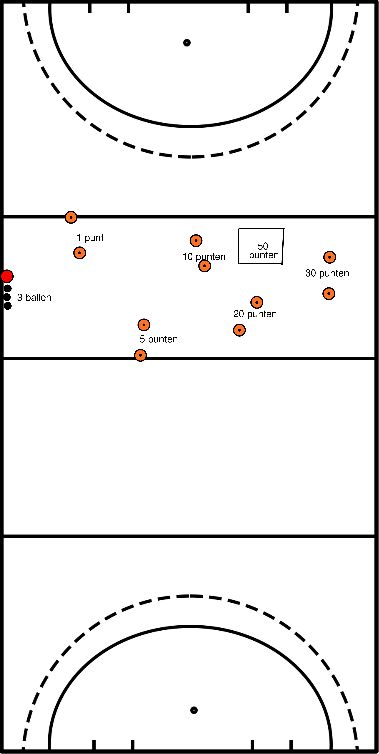
- You start with 3 teams, A, B and C.
- The game will be played on about half a field,
- the ball divider/referee is in the centre of the field in a marked square,
- this square can't be played through.
- There is a goalkeeper in the goal and two goals on the half way line.
- Team A starts defending,
- team B is attacking,
- team C is divided over the 2 small goals.
- Team A has to make sure the ball reaches team C.
- At this moment team B is defending and attacking team C.







